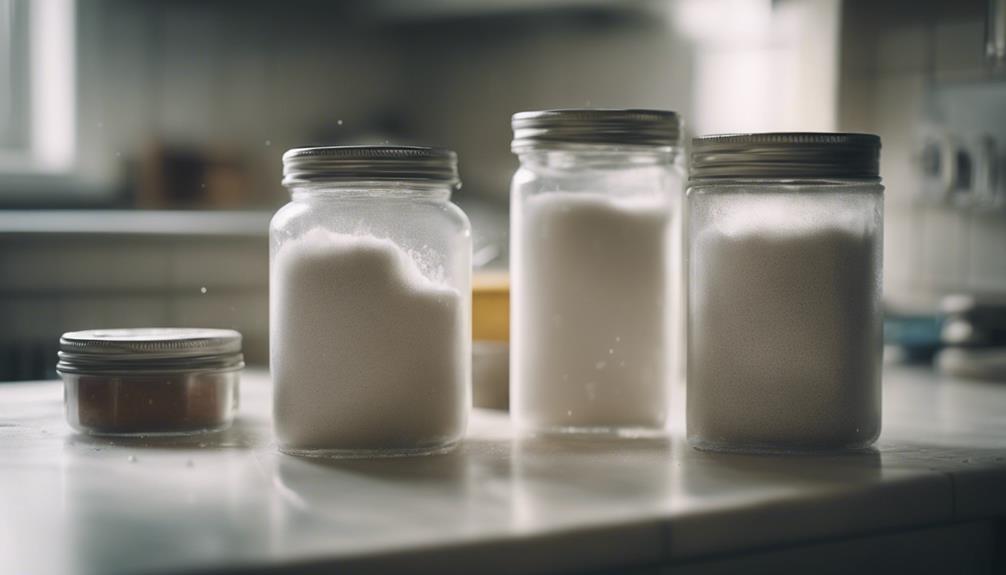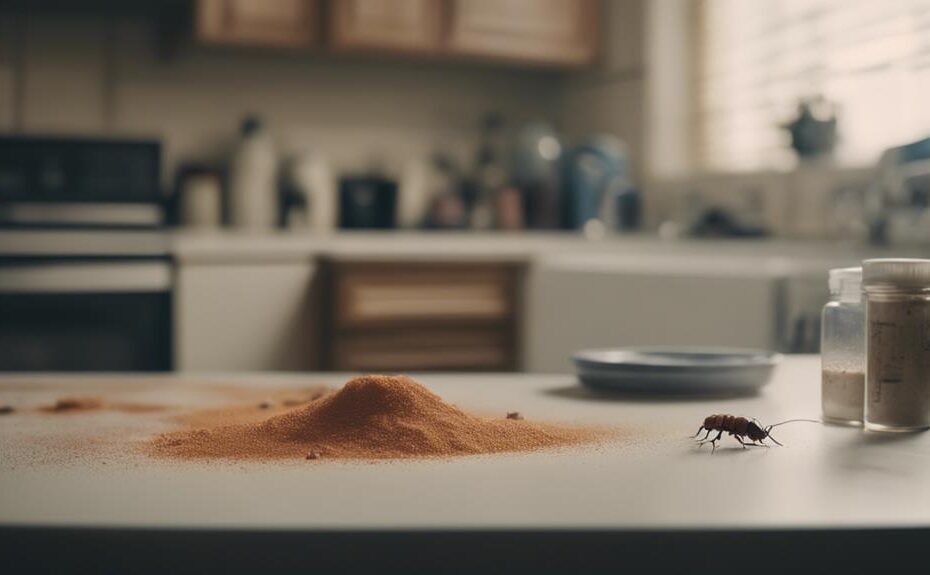Boric acid is a well-known remedy for dealing with roach infestations due to its effectiveness in eradicating these pests. Understanding the mechanism through which boric acid works to eliminate roaches is crucial in maximizing its potential.
However, there are additional factors to consider when utilizing boric acid as a pest control method, such as application techniques and safety precautions. By exploring the various aspects of boric acid use against roaches, a more comprehensive approach can be achieved in addressing this common household problem.
How Boric Acid Kills Roaches
Boric acid kills roaches by disrupting their digestive system when ingested in small quantities. This method of extermination targets the roaches' behavior of grooming and feeding on contaminated surfaces. Once ingested, boric acid interferes with the roaches' metabolism, leading to dehydration and eventual death.
Chemical reactions play a crucial role in how boric acid affects roaches. When roaches consume boric acid, it reacts with their stomach acid to form boric acid salt. This salt damages the roaches' digestive system, preventing them from properly digesting food and absorbing nutrients. As a result, the roaches become weakened and are unable to survive.
Understanding roach behavior is essential when using boric acid as a pest control method. Roaches are attracted to boric acid due to its resemblance to food particles, making it an effective bait. Additionally, the slow-acting nature of boric acid allows for the infected roach to return to their nest before succumbing to the effects, potentially eliminating an entire colony.
Benefits of Using Boric Acid
The effectiveness of boric acid as a roach control method stems from its ability to disrupt the digestive system of the insects, leading to their eventual demise.
One of the key benefits of using boric acid for pest control is its eco-friendly nature. Unlike harsh chemical pesticides, boric acid offers a sustainable roach extermination solution that is gentle on the environment.
This natural method is not only effective at eliminating roaches but also minimizes the impact on other non-target organisms and the surrounding ecosystem.
Additionally, boric acid has a long-lasting residual effect, providing extended protection against roach infestations. Its mode of action is unique in that it targets the insects' physiology, making it an efficient and reliable solution for pest management.
Where to Apply Boric Acid

When applying boric acid for roach control, it is crucial to target specific areas where roaches enter your living space, such as cracks and crevices.
Additionally, focusing on hidden harborages where roaches typically nest and breed can effectively disrupt their populations.
Areas with high roach activity, like kitchens and bathrooms, should be treated with boric acid to maximize its impact on the roach infestation.
Targeted Roach Entry Points
To effectively combat roaches using boric acid, it is crucial to strategically target their entry points within the premises. Implementing roach proofing techniques and sealing entry points are essential steps in this process. By blocking off the pathways through which roaches enter a space, the effectiveness of boric acid application can be maximized. Below is a table detailing common roach entry points and how boric acid can be applied effectively in those areas:
| Entry Point | Application of Boric Acid |
|---|---|
| Cracks in Walls | Inject boric acid powder using a duster |
| Gaps around Pipes | Apply boric acid along the pipe seams |
| Under Appliances | Dust boric acid underneath appliances |
| Behind Cabinets | Sprinkle boric acid powder in cracks |
Hidden Roach Harborages
In what hidden areas do roaches commonly seek harborages for applying boric acid effectively? Roaches have specific nesting habits, favoring dark, humid, and warm spaces. Common harborages include behind appliances, in wall voids, under sinks, and within cluttered areas.
Signs of roach infestation, such as feces, shed skins, and a musty odor, can help pinpoint these hidden locations. To effectively target these harborages with boric acid, apply the powder along baseboards, in cracks and crevices, and near plumbing fixtures. The fine particles of boric acid adhere to the roaches' bodies, eventually leading to their demise.
High Roach Activity Areas
For effective eradication of roaches using boric acid, it is crucial to target high roach activity areas strategically. Roaches tend to congregate in areas with easy access to food, water, and shelter.
Common high roach activity areas include kitchens, bathrooms, basements, and areas near food storage or disposal. These locations provide ideal conditions for roach infestation due to the presence of moisture, warmth, and food sources.
When applying boric acid in high roach activity areas, focus on crevices, cracks, and corners where roaches are likely to travel. This targeted approach enhances the effectiveness of pest management by directly impacting roaches' habitats and pathways, reducing their population over time.
Strategic application of boric acid in high roach activity areas is essential for long-term control and prevention of infestations.
Safety Precautions When Using Boric Acid

When utilizing boric acid for roach control, prioritizing safety measures is essential to minimize potential risks. Respiratory protection is crucial when handling boric acid powder to prevent inhalation of the fine particles, which can irritate the respiratory system. It is recommended to wear a mask rated for particulate matter to avoid any respiratory issues. Additionally, gloves should be worn to protect the skin from potential irritation.
Environmental impact is another critical aspect to consider when using boric acid for roach control. While boric acid is considered to have low toxicity to humans and pets when used appropriately, it can have adverse effects on non-target organisms in high concentrations. To minimize environmental impact, it is important to use boric acid sparingly and only in areas where roaches are present. Care should be taken to avoid contaminating water sources or exposing beneficial insects to the substance.
Combining Boric Acid With Other Methods
One effective approach to enhancing roach control efficacy involves strategically integrating boric acid with complementary pest management methods. By combining boric acid with alternative methods, a more comprehensive and efficient approach to roach elimination can be achieved. Combination strategies not only target roaches at different stages of their life cycle but also address various entry points and hiding spots within the infested area. This integrated approach maximizes the effectiveness of pest control efforts while minimizing the chances of roaches developing resistance to a single method.
Key Points:
- Implementing bait stations alongside boric acid application to attract and eliminate roaches more effectively.
- Using diatomaceous earth in conjunction with boric acid to create physical barriers that dehydrate and kill roaches.
- Employing ultrasonic pest repellents alongside boric acid treatment to deter roaches from inhabiting the treated area.
Tips for Maintaining a Roach-Free Home

To maintain a roach-free home successfully, it is crucial to implement prevention techniques such as:
- Sealing cracks and crevices
- Keeping food tightly sealed
- Reducing clutter
Effective roach control involves:
- Regular cleaning
- Using baits and traps strategically
- Consistent monitoring to detect any signs of infestation early on
Prevention Techniques
Implementing effective prevention techniques is crucial for maintaining a roach-free home, ensuring a clean and healthy living environment for you and your family. To prevent roach infestations, consider the following strategies:
- Natural Repellents: Use natural deterrents such as essential oils like peppermint, cedarwood, or eucalyptus to ward off roaches.
- DIY Traps: Create homemade traps using simple materials like a jar with a bait of sugar and baking soda to attract and trap roaches.
- Sealing Entry Points: Seal cracks, crevices, and gaps in walls, windows, and doors to prevent roaches from entering your home.
Effective Roach Control
Effective roach control methods are essential for maintaining a roach-free home and safeguarding your living space from infestations. Utilizing natural alternatives can be an eco-friendly way to combat roaches without harsh chemicals.
Essential oils like peppermint, cedarwood, or lavender are known to repel roaches due to their strong scents. Placing DIY traps can also help in monitoring and reducing the roach population in your home. Simple traps using boric acid or a mixture of sugar and baking soda can be effective in luring and eliminating roaches.
Regularly cleaning your living space, sealing cracks and crevices, and eliminating food sources are crucial steps in preventing roaches from entering and thriving in your home. Applying these methods diligently can significantly reduce the chances of a roach infestation.
Frequently Asked Questions
Can Boric Acid Be Harmful to Pets or Children if Ingested Accidentally?
Pet safety must always be a top priority to prevent ingestion risks. Similarly, child safety is paramount to avoid accidental consumption. Proper storage, childproof containers, and immediate action in case of accidental ingestion are essential safety measures.
How Long Does It Take for Boric Acid to Effectively Eliminate a Roach Infestation?
The effectiveness timeline of boric acid in pest control varies based on factors like pest type, infestation severity, and application techniques. Understanding these variables is crucial for achieving optimal results in eliminating pests.
Are There Any Specific Types of Roaches That Are Resistant to Boric Acid?
Roach behavior can vary by species, impacting pest control techniques' effectiveness. Some types, like German roaches, exhibit resistance to certain methods due to unique traits. Understanding species-specific behaviors is crucial for successful eradication.
Is It Safe to Use Boric Acid in Areas Where Food Is Prepared or Stored?
Utilizing boric acid in food-preparation or storage areas warrants caution due to potential chemical reactions. Understanding its environmental impact is crucial. A meticulous approach is necessary to ensure safety and efficacy in such sensitive environments.
Can Boric Acid Attract More Roaches to the Area Before Eliminating Them?
Roaches are attracted to areas where food and water sources are abundant. This behavior can lead to infestations. To prevent roach attraction, it is crucial to maintain cleanliness, limit access to food, seal entry points, and eliminate moisture.
Conclusion
In conclusion, boric acid is an effective method for killing roaches due to its desiccating properties that dehydrate and ultimately kill the insects.
It is estimated that boric acid can eliminate up to 95% of roaches in a treated area, making it a highly successful solution for controlling infestations.
When used correctly and in conjunction with other methods, boric acid can help maintain a roach-free home.

